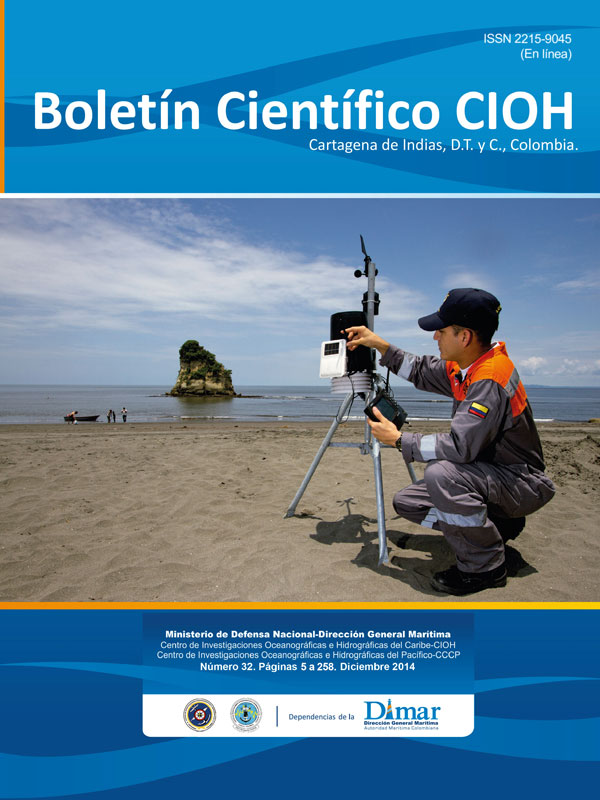Cartagena bay water mass exchange based on measurement of oceanographic parameters (Colombian Caribbean
DOI:
https://doi.org/10.26640/22159045.263Keywords:
Exchange of water masses, dynamic estuarine, Cartagena BayAbstract
Was performed a description and analysis of the process of exchange of water masses in the bay of Cartagena, for which there were effected field exits, in which there took different measurements of oceanographic parameters in the income of the bay (Bocagrande and Bocachica), as well as in the unload of the Channel of the Dique in the bay. Other contributions of water were not born in mind. The measurements were effected in two epochs (dry and humid), in order to determine the influence of the seasonal ends in the dynamics of the bay, principally of the Channel of the Dique, which during the epoch of rains, approximately trebled the contribution in the water volume towards the bay. During the dry epoch and in Bocachica's sector (measurements effected during a cycle of tide) one presented a dominant flow towards the bay, correspondent to a volume of 59.1567x106 m3 during a cycle of tide and an outflow for Bocagrande corresponding to a volume of 76.2013x106 m3, with a decrease of 28.81% in the water volume of the bay; In the epoch of rains and during a cycle of tide, the water volume that entered to the bay (Bocachica and Channel of the Dique) was of 89.8590x106 m3, whereas the volume of exit for Bocagrande was of 78.5392x106 m3, with an increase of 12.59% in the water volume of the bay. These results corroborate the obtained ones for Molars and Mestres (2013), who simulated the dynamics of the bay and determined a variation in the rate of flow of entry and exit to the bay depending of the epoch of the year. There is highlighted the importance of the obtained results, which indicate the variations of the water volume inside the bay, acquiring importance for the socioeconomic and ecological impact that can have in this important system estuarino.Downloads
References
[2] Hsu M, Kuo AY, Kuo J, Liu W. Procedure to Calibrate and Verify Numerical Models of Estuarine Hydrodynamics. Journal of Hydraulic Engineering 1999;125(2):166-182.
[3] Matsuno T, Shigeoka M, Tamaki A, Nagata T, Nishimura K. Distributions of water masses and currents in Tachibana Bay, west of Ari-Ake Sound Kyushu Japan. Journal of Oceanography 1999;55:515-529.
[4] Hibmaa A, Stivea MJF, Wang ZB. Estuarine morphodynamics. Coastal Engineering 2004;51:765-778.
[5] Lozano Y, Medellín J, Navas, G. Contexto climatológico y oceanográfico del mar Caribe colombiano. En: Biodiversidad del margen continental del Caribe colombiano, Serie de Publicaciones Especiales Invemar, N° 20, Invemar (Eds.), pp. 53-81; 2010.
[6] Palacio C, García F, García U. Calibración de un modelo hidrodinámico 2D para la bahía de Cartagena. Dyna, Nº 164, pp. 152-166; 2010.
[7] Lonin S y Giraldo L. Circulación de las aguas y transporte de contaminantes en la bahia interna de Cartagena. Bol. Cient. CIOH 1995;16:25-56.
[8] Tuchkovenko YS, Lonin S, Calero LA. Modelo de eutroficación de la bahía de Cartagena y su aplicacion práctica. Bol. Cient. CIOH 2002;20:28-44.
[9] Molares R, Mestres M. La influencia de la descarga del Canal del Dique en los niveles del mar de la bahía de Cartagena-Colombia. Bol. Cient. CIOH 2012;30:13-28.
[10] Molares R, Mestres M. Efectos de la descarga estacional del Canal del Dique en el mecanismo de intercambio de aguas de una bahía semicerrada y micromareal: bahía de Cartagena, Colombia. Bol. Cient. CIOH 2012;30:53-74.
[11] Pagliardini JL, Vernette G, Gómez M. Síntesis del proyecto bahia de Cartagena. Bol. Cient. CIOH 1982;4:49-110.
[12] Lonin S, Parra C, Andrade C, Thomas Y. Patrones de la pluma turbia del Canal del Dique en la bahía de Cartagena. Bol. Cient. 2004;22:77-89.
[13] Aguilera M. El Canal del Dique y su subregión: una economía basada en la riqueza hídrica. Banco de la República. Bolívar: Cartagena de Indias. Vol. 72; 2006, 87 pp.
[14] Garay J, Giraldo L. Influencia de los aportes de materia orgánica externa y autóctona en el decrecimiento de los niveles de oxígeno disuelto en la bahía de Cartagena. Bol. Cient. CIOH 1998;18:1-13.
[15] Zambrana B, Marín G. Estado de los estuarios y lagunas costeras en Colombia año 2000. Informe del estado de los ambientes marinos y costeros en Colombia: año 2000: 70 83; 2000.
[16] Gómez A, Osorio A, Toro F, Osorio J, Álvarez O. Efecto del cambio de los caudales del Canal del Dique sobre el patrón de transporte horizontal en la bahía de Barbacoas. Bol. Cient. CIOH 2009;27:90-111.
[17] Ordóñez JI, Cubillos Peña CE, Forero G. Balance hídrico y sedimentológico del Canal del Dique y sus efectos sobre la sedimentación de la bahía de Cartagena. Laboratorio de ensayos hidráulicos, Universidad Nacional de Colombia; 2007. Pp. 1-18.
[18] Franco E, Gómez J. Evolución de la línea de costa del litoral antioqueño. Aspectos geomorfológicos, sector: río Necoclí–Turbo. Trabajo de grado; 1996. 106 pp.
[19] Valdés C. Unidades de Paisaje. En: Lineamientos del ordenamiento territorial del distrito turístico y cultural de Cartagena de Indias. Cartagena; 2001. 206 pp.[20] Urbano JE. Masas de agua del Caribe colombiano. Bol. Cient. CIOH 1993;14:3-30.
[20] Urbano JE. Masas de agua del Caribe colombiano. Bol. Cient. CIOH 1993;14:3-30.
Downloads
Published
Issue
Section
License
Attribution — You must give appropriate credit, provide a link to the license, and indicate if changes were made. You may do so in any reasonable manner, but not in any way that suggests the licensor endorses you or your use.
NonCommercial — You may not use the material for commercial purposes.
NoDerivatives — If you remix, transform, or build upon the material, you may not distribute the modified material.
No additional restrictions — You may not apply legal terms or technological measures that legally restrict others from doing anything the license permits.



